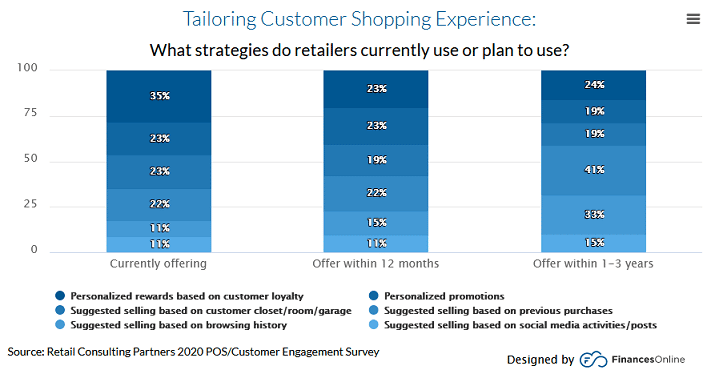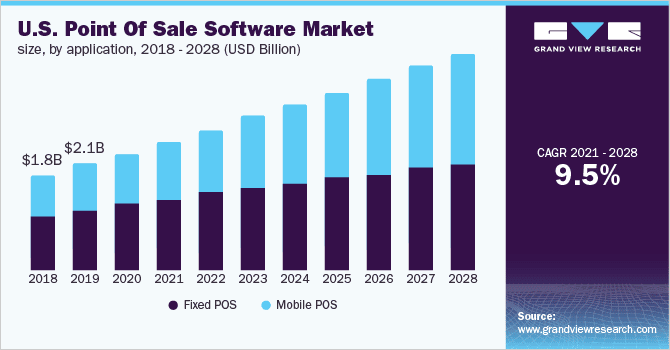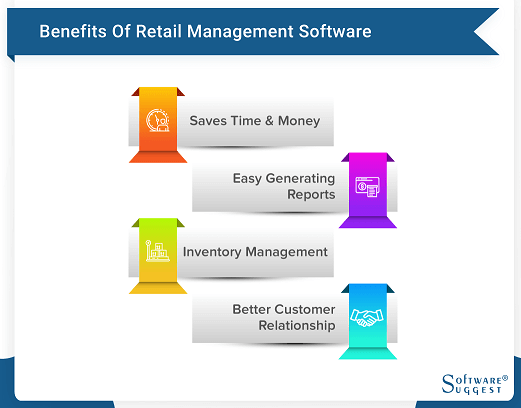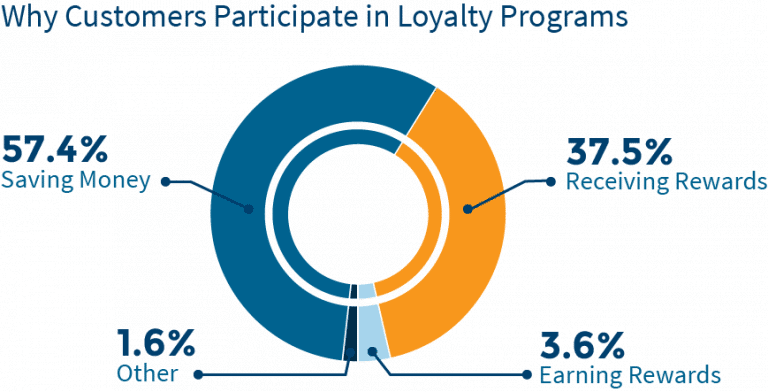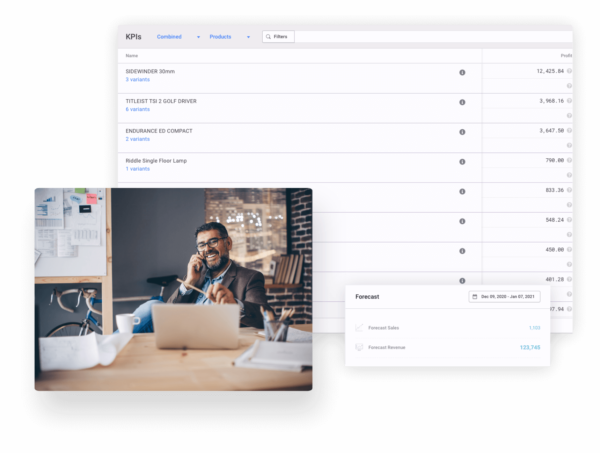What is retail management software?
Retail management systems assists e-commerce and offline businesses in managing their key retail processes. This includes back-office operations, inventory control, employee management, and customer relationship management.
Not so long ago, retail management software was an enhanced POS system with a few extra ERP functions. But these days, the POS tends to be one component of a comprehensive solution with a raft of other retail management features.
By combining tools in a single platform, modern software streamlines business processes and workflows. It typically incorporates inventory and supplier management, CRM, analytics, and a POS solution—syncing real-time data from all elements for maximum efficiency.
With insights into your operations, you can keep track of sales, make more accurate demand forecasts and marketing decisions, and provide a better customer experience.
What does retail management system software help with?
Retail management system software helps with all the main aspects of running a retail business, ensuring the various elements work together seamlessly to keep everyone productive.
Inventory management
Effective inventory management is crucial. You need full visibility across warehouse locations, physical stores, and sales channels in order to prevent problems like stockouts and excess stock. With a retail management system, all the data is collected in a central place and updated whenever there’s a change—such as sales, transfers, shipments, or returns.
The best software (like Brightpearl) also comes with automation, which makes it easier to perform cycle counts and audits. Barcoding and RFID tagging help staff to locate items quickly, while the system can also generate picklists and shipping labels. Get alerts when stock is low, and set rules for automatic re-ordering.
CRM
A built-in CRM means you can use customer data to inform all your activities, from improving your marketing efforts to offering flexible payments and better customer support. It helps you develop relationships, track customer lifetime value, and figure out how to retain loyal shoppers and attract new ones.
Once you get to know your customers, you can use segmentation to personalize services. With instant access to customer information, all staff can be proactive and deal with any issues efficiently. You can also log and review customer feedback. 81% of sales reps believe it is important to have a connected view of data across the entire customer journey.
Source: financesonline.com
Vendor management
Retail management systems also enable you to manage your vendors all in one place, so you can easily see which products are associated with which suppliers, and keep track of sources of data such as purchase orders, invoices, and payments.
With strong communication, you can build solid relationships and negotiate the best deals. The software syncs data between your businesses, so everyone gets an early warning if there’s a problem. Some automated tools can be programmed to select the most suitable supplier for each order.
Reporting and analytics
This type of software usually contains analytics and reporting capabilities to give you an overview of retail performance. This may include replenishment reports that show you how much new stock to order, product performance analysis to highlight your best and worst sellers, and the ability to monitor workforce performance.
It also assists with demand planning, so you can identify peak times and ensure you have enough staff to cope. You can regularly evaluate the rates you’re getting from suppliers and shipping carriers, and use customer feedback to investigate problems and tackle them before they happen again.
POS
For brick-and-mortar stores, a retail point of sale system is essential, but it has a positive effect on your e-commerce store operations, too. It provides visibility into inventory levels throughout the business, and automatically syncs data between online and offline channels.
Staff can instantly see stock availability in-store and elsewhere, so they can fulfill from another location or place a backorder if necessary. A mobile POS lets you process orders and payments from anywhere (even if there’s no internet connection), so customers don’t have to visit a fixed checkout—and it’s handy for food trucks and trade fairs.
Source: grandviewresearch.com
Benefits of retail management system software
Whether you’re a startup or an established business, it’s always a good time to introduce retail management system software to your tech stack. Here are a few of the benefits:
Increased efficiency
Having all your tools in one centralized system improves efficiency and productivity, as you don’t have to toggle between separate apps. Data from the built-in features (and integrations) is synced and updated automatically, making it easier to handle multichannel and multi-location retail.
Automation helps you accelerate workflows and reduce human error, as there’s no need for manual data entry. You can keep a close eye on stock levels and reorder at the optimum time, as well as processing orders faster. The software simplifies the returns process, and brings extra efficiency to customer service.
Another bonus is that efficiency reduces your costs, especially when the software is based in the cloud.
Consistency in performance
Automation also gives you consistency. The software helps you figure out how to make your workflows more effective, and set your own rules so that the system completes specific tasks automatically. So, they’ll always happen in the exact same way. With documents like purchase orders, invoices, and packing slips generated automatically, there are fewer errors.
Workforce management capabilities show you if anyone’s struggling to meet their targets, so you can provide more training. It’s easier to evaluate product performance and deliver a consistent customer experience across all online channels and offline stores.
Makes your business objectives the main focus
When you don’t have to spend so much time on tedious manual tasks (thanks to advanced tools and automation), it frees you up to concentrate on more complex aspects of running a retail business and look toward your future goals.
Retail management software provides business intelligence to check if you’re meeting your targets and find areas for improvement. You can communicate with all staff through the central system, which makes it simple to share objectives as well as data. Plus, with extra efficiency and reduced costs, you could expand your e-commerce empire and get ahead of your competitors.
Source: softwaresuggest.com
How to select the best retail management system software
The variety of software systems available for retail management can feel overwhelming. Your choice will ultimately depend on your particular business needs, but there are a few essential elements to look out for.
Key features to look for in a retail management system software
Platforms
Firstly, the software must be easy to use. That means a simple interface, and the ability to access the system from a wide range of devices and operating systems. And not just for staff—it should be easy for customers to make payments, track orders, arrange returns, and enjoy the same smooth experience whichever channel or device they use.
The best retail management systems will also give you plug-ins or integrations that help you spin up a new e-commerce store on platforms like Shopify or Amazon, and sync the data between them all.
Dashboards
Your system should have an intuitive dashboard where you can easily view the latest stats at a glance, or drill down into the finer details of a certain area. This should be accessible to everyone who uses the software. The most helpful dashboards present the information in a visual way to make it simple to understand, and also generate reports to help you optimize inventory or staffing levels.
Loyalty programs
Loyalty programs help retailers to increase revenue by encouraging customers to make repeat purchases. 59.48% of shoppers say that they’d happily join such a program for a brand they already felt loyal to.
Your business will definitely see the benefits, but you’ll need software that makes it easy to administer rewards to customers and keep track of their points. It’s also a good idea if your retail management system integrates with amarketing tool, so that you can let customers know more about the program and the rewards they’re getting.
Source: invespcro.com
Cross selling and upselling
Retail management software helps you identify the best opportunities for upselling and cross selling. A CRM feature lets you get to know your customers better, while analytics and reporting tools show you peak sales times—when are people visiting certain channels? Which products are most popular? What motivates customers to add to their cart?
The system also enables you to group similar products, so that sales staff can make recommendations during transactions. Again, you can send special offers to customers via marketing integrations.
Payment flexibility
Customers love convenience, and that extends to payment methods. A robust retail management system lets you process various forms of payment, including cash, card, gift vouchers, and digital wallets.
This kind of flexibility is important for both online and offline sales, so the in-store POS should have the same capability. And it’s important that all payment data is housed in the same place for ease of administration and awareness of your real-time financial status.
Promotions
Your retail management software should also make it easy to offer promotions. You can use the analytics to see which methods work best and who to offer them to, whether it’s rewards for VIP customers or free shipping with a minimum order threshold.
Integration with email marketing apps allows you to automatically send promotions to certain people, including cart abandoners and lapsed customers. Entice them with personalized offers using sales data and information from your CRM.
Integrations
While a retail management system is all about combining your retail tools into a single platform, it’s important that it also works seamlessly with your other business systems. For example, you’ll want to share data from your accounting and marketing apps, as well as coordinating with shipping and 3PL partners. The ability to bolster your tech stack with integrations will boost productivity and help you scale without overspending.
10 Best retail management system software options
There’s a wide array of retail management solutions on the market. Some are fully comprehensive while others are more like an expanded POS—with the expected differences in price and capability. We’ve chosen 10 of the most popular systems, so you can judge for yourself.
1. Brightpearl
Brightpearl is more than a retail management system—it’s a complete retail operating system that centralizes and automates all your critical post-purchase operations. The cloud-based software is designed for e-commerce retailers and wholesalers, and comes with unlimited 24/7 support.
Its RMS features include inventory control dashboards with multichannel and multi-location data synced automatically—plus replenishment recommendations and demand forecasting. Advanced business intelligence gives you analytics and reporting, while the CRM offers a 360-degree customer view.
The built-in POS provides integrated payments and makes it simple to complete refunds and exchanges, offer promotions, accept gift cards, and operate a loyalty scheme. Alongside these functions, you also get order management, warehouse management, and built-in retail accounting—all in one platform.
Because Brightpearl aims to help your business grow, you can add as many users as you need without paying extra (and there are a ton of integrations that you can add when you need them). Reviewers praise the system’s ease of use and the great customer support.
Price: Brightpearl’s prices are customized, so you’ll never pay for more than you need. Get in touch for a quote.
Benefits of working with Brightpearl
Brightpearl is the complete package for all your retail operations. With an array of advanced tools and integrations in one place, your business can streamline its processes and make everyone more productive. For example, the Automation Engine can save you two months a year on average, and cut your labor costs in half.
The inventory management features give you full visibility across all channels and locations, updating instantly when stock is sold or transferred. You can set reorder points and get notifications when inventory levels fall, as well as viewing replenishment reports and product performance analysis (which is just one part of Brightpearl’s business intelligence).
The built-in POS makes it easy to share data between online and offline stores, showing real-time availability and enabling backorders, discounts, and loyalty programs. And the CRM provides in-depth knowledge of customer preferences and behaviors, with segmentation and automated communication reminders.
The whole system is secure and hyper-scalable, meaning your business can Grow Fearlessly—there’s no limit to the number of users, products, customers, or integrations you can add. As you scale, you’ll benefit from stellar customer support and even a dedicated Customer Success Manager.
Additional features of Brightpearl’s retail operating system
Alongside advanced tools for retail management, Brightpearl enables you to make all your supply chain operations more efficient. Automation plays a large part, such as automated order processing and routing workflows based on your own rules, and auto-generated picklists, packing slips, and shipping labels.
You can also automate partial or multi-location fulfillment, dropshipping, and order splitting, and select a shipping carrier based on customer, channel, or price. The warehouse management feature also gives you configurable workflows, flexible order picking and cycle counts, multiple barcode support, and hassle-free returns.
With centralized supplier management, you can keep track of purchase orders and payments. Brightpearl also has built-in retail accounting for real-time financial insight, including multi-currency support, integrated landed costs, batch invoicing, and dynamic unit cost tracking.
The Demand Planner helps you identify peak times and figure out which products to invest in, as well as understanding wider business performance based on key metrics for products, warehouses, sales channels, and suppliers. You’ll be able to manage your retail business with ease.
Final thoughts
There’s no reason to struggle with a collection of separate tools for retail management—it makes more sense to invest in a system with full functionality in one platform. By integrating the key components of inventory management, analytics, CRM, POS, and supplier management, you’ll find it much easier to improve efficiency and reduce costs.
Even better, choose software that goes beyond basic retail management and assists you with all your retail operations. Brightpearl’s Automation Engine and scalable tech stack will help you handle omnichannel and multi-location commerce, and stay ahead of your rivals in the competitive online retail industry.


